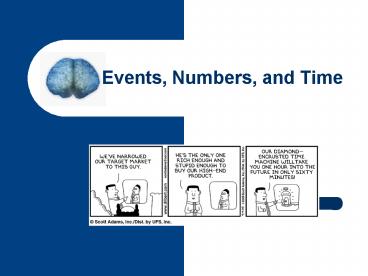Events, Numbers, and Time PowerPoint PPT Presentation
1 / 27
Title: Events, Numbers, and Time
1
Events, Numbers, and Time
2
Zeroth order theory
- Time is what keeps everything from happening all
at once. - Space is what keeps everything from happening to
you. - Number is what tells you just how bad things are.
3
Qualitative Representations
- Symbolic reasoning about continuous properties
requires quantization - Qualitative representations of space and time
need to be based on natural decompositions - Where and when what is happening is different
- Task-specific constraints
4
Time Some typical choices
- Represent time in terms of intervals and instants
- Sometimes instants mapped to numbers, intervals
to numerical intervals - Ex t17.3 seconds, engine firing 223, 457
- Reasoning can include calculations of durations
- Often purely relational vocabulary used
- Ex The lecture was before lunch, but the
projector broke during the lecture. - Reasoning by transitivity The projector broke
before lunch - Properties of temporal algebras have been heavily
studied
5
How to individuate time?
- Properties of physics
- Cultural conventions
- Occurrence of events
- Uniform behavior or events
- Quantization of time often tied to quantization
of number and space - The water heated up and then started to boil
- After a long flight, the passengers disembarked.
6
Temporal representations can havecomplex
structure
7
Fluents
- Time-dependent physical quantity (Newton)
- Functions (Leibniz)
- Implicit notation
- ? always
- ? sometimes
- Explicit notation
- ( tTime)
- ( tTime)
8
Issues in representing numbers
- Resolution
- Composability
- Graceful Extension
- Relevance
9
Resolution
- Fine versus coarse?
- How many distinctions can be made?
- Fixed versus variable?
- Can the number of distinctions made be varied to
meet different needs?
10
Composability
- Compare
- How much information is available about relative
magnitudes? - Propagate
- Given some values, how can other values be
computed? - Combine
- What kinds of relationships can be expressed
between values?
11
Graceful Extension
- If higher resolution information is needed, can
it be added without invalidating old conclusions?
12
Relevance
- Which tasks is this notion of value suitable for?
- Which tasks are unsuitable for a given notion of
value?
13
The Reals
- Most familiar
- Originally intended as a model of continuous
things - Some important properties
- Continuity
- Density
14
Continuity
- You cant get from A to B without going through C.
15
Density
- Between any two real numbers you can always find
a third
16
Finite Fixed Algebras
- One of the first qualitative schemes proposed
- Example Height is one of
- very short, short, medium, tall, very tall
- Built-in order relation
- Example tall gt short
17
Problems with finite fixed algebras
- Compositionality
- short tall ???
- Hard to extend
- If height 6 foot
- ? ?height short
- ? ?height tall
18
Signs
- The first representation used in QR
- The weakest that can support continuity
- if A - then it must be before A 0 before
A - Can describe derivatives
- ?? ??increasing
- ?? 0 ??steady
- ?? - ??decreasing
19
Status Abstraction
- Even weaker than signs!
- A okay
- A faulted
- Useful for diagnosis
- Faultfinder (Abbott, 1988)
- Xerox PARC group (1990s)
20
Ordinals
- Describe value via relationships with other
values - A gt B A lt C Alt D
- Allows partial information
- in the above, dont know relation between C and D
- Like signs, supports continuity and derivatives
21
Nomenclature
- Quantity Space (range)
- Value defined by set of comparisons with other
parameters - Example T(w) gt T(freeze) T(w) lt Tboil(w)
T(w) lt T(stove) - T(freeze), Tboil(w) are examples of limit points
- Specialization Value Space
- Quantity space where imposed order is total
- Example The above, but also Tboil(w) lt T(stove)
22
Intervals
- Pin value down to a range (typically of reals)
- Example T(w) (0, 100) at room conditions
- Can be used to express tolerances
- Variable resolution
- Use wider or narrower intervals
- Whole field of mathematics devoted to
calculations using intervals
23
Intervals can be tricky
- Consider
- AZ/(X-Y)
- Z1,2 X2,4 Y3,5
- A?
24
Fuzzy Logic
- Claim Endpoints of intervals are too crisp
- Represent value by distribution
25
Issues in Fuzzy Logic
- Elkins critique
- Violates basic logical intuitions
- Applications successful because of continuous
parameters, not specific claims of fuzzy logic - Some find it useful
- Leitchs work on FuSim
- Flakey the robot
26
Order of Magnitude
- Provides stratification of values
- Larger effects completely dominate
- Smaller effects can be ignored
- Example Ignore evaporation when boiling is
occurring. - Several interesting formalisms, still some
shaking out to do - Logical consistency
- When do small effects break through to the next
level? - Phase shifts
27
- Events in our lives happen in a sequence in time,
but in their significance to ourselves they find
their own order the continuous thread of
revelation. - Eudora Welty

